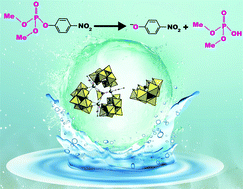Trisubstituted 4f- and 4d tungstoantimonates as artificial phosphoesterases for nerve agent degradation†
Abstract
Three new trisubstituted 4f- and 4d tungstoantimonates (TA) K3Na21[(M(CH3COO))3(HPO3)(WO4)(SbW9O33)3]·nH2O {M3(HPO3)Sb3W28} (M = GdIII, YIII, YbIII, n = 35–36) were synthesized using a double-template synthetic approach. Following their characterization in the solid state employing single- and powder X-ray diffraction (XRD), IR-spectroscopy, and elemental – and thermogravimetric analyses (TGA), {M3(HPO3)Sb3W28} were subjected to a comprehensive set of solution characterization methods including UV/vis- and multinuclear 31P and 13C NMR spectroscopy. All representatives were shown to be highly active, recyclable, and stable Lewis-acid catalysts towards the nerve agent simulant O,O-dimethyl O-(4-nitrophenyl) phosphate (DMNP) at neutral pH (in Tris–HCl [125 mM] at pD 7.0 25 °C). Control experiments showing catalytic activity of the unsubstituted trilacunary TA [SbW9O33]9− suggest the non-innocence of Tris in the DMNP hydrolysis for the first time.



 Please wait while we load your content...
Please wait while we load your content...